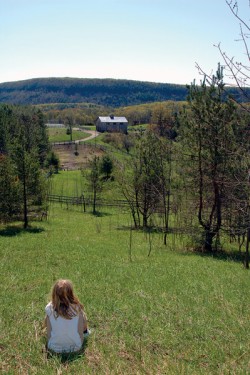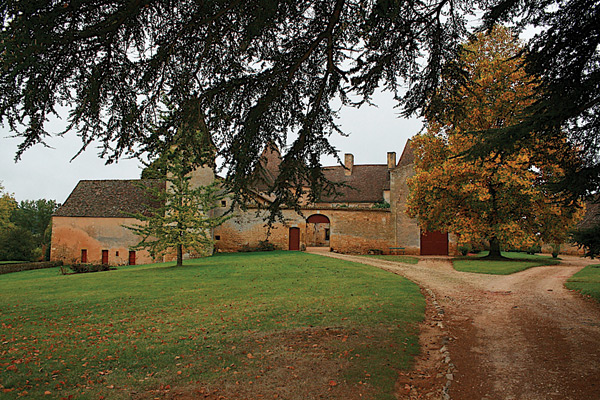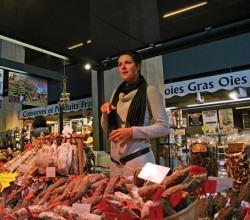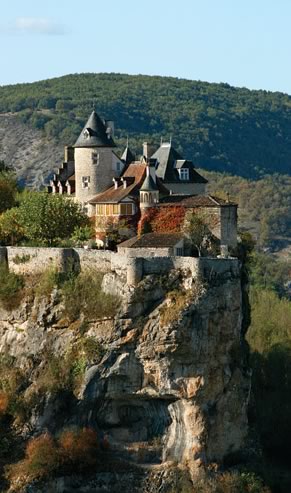Caledon and la Dordogne: Home truths from deep France
A traveller discovers striking parallels and telling differences between rural Dordogne and her Credit River home in Brimstone.
Thick morning fog is common year-round in the Dordogne Valley near Sarlat. This mild October dawn is no exception. From our château terrace, perched on the basin’s south ridge, I watch the silhouette of nearby Fenelon Castle take shape, as if emerging from a medieval dream.
The kids still sleep as I await my husband Tim’s return from what will be daily runs to the local boulangerie. It seems this quiet corner of southwestern rural France almost insists that one slow down and reflect. In this solitary moment, morning coffee in hand, I’m happy to oblige.
Though I feel the haze of jetlag still burning off, two clear thoughts come to mind. First – wow, I have a great job! As a communications consultant to a little luxury villa company, I’m sent off now and again to explore some of Europe’s most lovely back roads. Crazy lucky, I know. But I think also of the things I write for this gig from my Brimstone office back home: “Savour the unchanging sights and sites… live the gentle timeless rituals of village and rural life…” It’s never a hard sell.
I know why North Americans are drawn to these places. We marvel at age-old landmarks, landscapes and unhurried traditions that defy time. Beauty and history aside, I think their sheer endurance restores and, more recently, reassures us that perhaps these wonky times too shall pass.
What I puzzle over – as I watch the heavy duvet of fog below dissolve into a delicate veil – is why we are so cavalier about discarding such riches in our own backyard? Like the panorama of tiny stone villages dotting the river valley below, the first of many such lessons we’ll learn from deep France is about to be revealed.
Lesson One – “Monsieur, It’s Just a Chocolate Croissant”
Voila, ma chérie. I bring warm baguettes and pain au chocolat,” announces Tim in his best Pépe le Pew imitation. The spell of my poolside ponderings is broken. “I’m not sure the Madame at the bakery understood my enthusiasm… or my high-school French.”
Tim’s encounter reminds me of a conversation with my friend and colleague, Jackie, a Dutch ex-pat who lives in the region and has hosted villa guests here for about ten years. “With a history dating back to Cro-Magnon man,” she explained, “the term ‘local’ here takes on new meaning. Natives of the Périgord (as it’s known locally) are, well, reticent to reveal their true character until they really know and like you.” Such is deep France or La France Profonde, where life looks and carries on pretty much as it has for centuries, not at all fluffed for tourists, nor does it need to be.
Now knowing Tim’s outgoing nature, I can almost picture the scene in this little village boulangerie. The subtext of the shopkeeper’s polite reserve I imagine reading this way: “Sir, we did not bow to the Romans, nor succumb to the English and, while we appreciate your business, we never play up to over-eager tourists. After all, Monsieur, it is just a chocolate croissant.”
If you don’t take it personally, there is something quite admirable about this quiet resolve. Jackie would say it stems from an almost primal connection to and protectiveness of the history and beauty of their region – something I’d like to bottle, bring home and sprinkle generously across the GTA.
I recognize this same sort of resolve in our Belfountain community as citizens battle new subdivision plans and gravel pit proposals. Still, across the Caledon Hills, we’re far from united on the development issue. As we “infill” historic villages and gobble up tracts of the Peel Plain, we have to ponder the tipping point, beyond which we lose the bucolic treasures that we value most.
So our first lesson here comes more in the form of an admonition, which I imagine Madame at the boulangerie putting this way: “You can’t have your chocolate croissant and eat it too.”
Lesson Two – Walnuts!
Walnuts are everywhere the second week of October in the Dordogne. This fact we discover not 500 yards from the courtyard gate of our temporary home, Château Espérance.
Snaking through the deep forest toward the valley floor, we come upon an unusually flat and evenly spaced stand of old hardwoods. Beneath its canopy an elderly couple hunches over, busily picking through something on the ground. Having stepped off the TGV at Bordeaux just the evening before, we don’t realize that the scene before us will likely repeat itself a thousand times across the region over the week ahead.
“Stop the car!” I blurt. We’re all curious now. “Bonjour, Madame, Monsieur,” I hail the couple as we stride up the embankment toward the focus of their efforts. Silently, I curse myself for skipping so many French classes in high school. “Pardon, s’il vous plaît. Qu’est-ce que c’est?” is the best I can muster pointing to her hand and the lumpy cache in her apron that she holds folded up to her waist.
“Bonjour,” she intones in that lovely native French way that anglophones can only dream of replicating. She smiles broadly then holds open her free hand to reveal three very large and perfect walnuts.
Somehow, between our broken French and their gestures, we learn they are the caretakers of Fenelon Castle up the road. She explains that they have lived in the area all of their lives and that she has been harvesting walnuts in groves like this since she was a small girl. Meanwhile, her husband shows Tim the technique for cracking walnuts with his thumbs. After several failed attempts, Tim insists it’s harder than the old man’s weathered hands make it seem.
It is easy, however, to see their delight in sharing their annual harvest custom with this family of foreigners. We will discover later that neat little bags of fresh walnuts are readily available in almost any store and we will see machines that pick up in minutes a walnut haul that would take weeks for these two to collect. At first glance, it seems to be back-breaking work for such a limited reward. Appearances, however, can be deceiving. We see also that the joy of this common seasonal rite is as embedded in their DNA as the rich soil of the forest floor is in their thick and gnarled hands.
This moment reminds me of picking wild apples each fall on our old property in Chinguacousy. The boys and I would spend hours peeling the undersized fruit and cutting out worm holes and hail marks. The resulting pies tasted better than anything, or so we thought. With those memories in mind, our lesson for today feels a bit like preaching to the choir: Sometimes our most common connections to the land offer the most rarified moments of joy and continuity; that is, if we don’t pave them over.
Lesson Three – The Nobleman
Today we drop by for a visit with Godefroy.
Distinguished and still handsome at 74, Godefroy Commarque looks every bit the part of patriarch to the Dordogne’s oldest surviving noble family. For over 700 years and twenty-three generations, the Commarques have lived on the same 600-acre estate in the heart of Périgord. As he stands before the immense arched doors opening to his courtyard, one might easily assume Godefroy has lived the uncomplicated and charmed life of France’s rural elite. However, beneath the carefree tweed-jacket-and-wellies veneer lies a bloody-minded commitment to this land and this region, reaching back to the very beginning of its recorded history.
“Leeze, I hear you ride,” he says. I love the way French men say my name. “When you visit next, we will ride the horses so you can explore the rest of the property.” Portfolio willing, this is an invitation we will, one day, accept.
I can only imagine, if these rolling pastures and ancient forests could talk, the stories they would tell.
Godefroy’s direct ancestors, whose horses grazed on the same bucolic landscapes, fought in the Hundred Years War; a nearby twelfth-century castle ruin with private, pre-historic caves at its foundations bears his family name; his château turret burned in the French Revolution; his grandfather Louis died from his wounds incurred while defending France in WWI; and in the final weeks of WWII, when Godefroy was just a young boy, the Gestapo captured his father Gérard, then killed him at Buchenwald concentration camp for his key part in the French resistance.
Over seven centuries, the Commarques have surmounted many great challenges to maintain, restore and keep their property in the family. It’s no stretch, I believe, to say Godefroy would sooner surrender a vital organ than lose connection to any part of this land. In more recent years, that’s meant renting out a wing of this gracious landmark to travellers.
“Next time, you and your family come and stay here,” he says as we make our goodbyes. Again, I’m keeping this invitation securely in my back pocket.
Of course, I imagine – if only the GTA had this same commitment to protecting its natural and rural heritage. It’s true, our rural traditions in Caledon don’t reach back 700 years and we face extraordinary pressures to grow, sitting at the back door of North America’s fourth largest urban centre. That said, today’s lesson from deep France still stands: There are no do-overs when it comes to honouring and preserving one’s heritage. Foresight, commitment and real sacrifice may be the price, but the rewards, as we see in Godefroy’s eyes, are priceless.
Lesson Four – Just Smile and Swallow
You can learn a lot about what’s right with French culture from their food – how they grow it, shop for it, prepare it, share it and the stuff itself.
The Dordogne, in every way, is a tasty classroom for that. Foie gras, truffles, fresh salads dressed with walnut oil, and duck prepared a dozen different ways – this region has great gastronomic traditions. And the wine, well, the reds of Bergerac and Cahors or the grand crus domaines of Saint-Émilion, Castillon and Pomerol are just a short trip away. The best of all this comes to us one night at Château Espérance, an artfully restored seventeenth-century presbytery and our home-away-from-home for the week.
Still, foreign food and children are always a tricky mix. “Just smile and swallow” – my sons Mack and James silently absorb the fear of god that I project in strong whispered tones.
Tonight, Jacques and Christine Rougié, the gracious owners who rent out Espérance, have come to host a dinner here prepared by their friend, chef Daniel Chambon. Daniel’s nearby restaurant Le Pont de l’Ouysse was awarded a coveted Michelin star – the equivalent of the Order of Canada for culinary arts. It’s a privilege hard for eight- and fifteen year-old boys to comprehend. Though on some level, I sense they get it.
Jacques, an international businessman from a renowned foie gras-producing family in Périgord, understands the magic of a fine French meal. He checks in briefly with Daniel, who busily attends to final touches in the same kitchen where we’d slapped together ham sandwiches earlier in the day. Soon Daniel emerges with a small plate of tiny morsels. A salmon/dill confection, oysters fresh that morning from Bordeaux and, of course, foie gras. They’re all sumptuous appetizers in the true sense of the word, just enough to heighten anticipation, no more.
What follows is like Christmas morning for the taste buds: delicate lentil and truffle soup, individual bowls of some rich fondue-type mixture, a luscious sliver of buttery tender duckling, a tangy wafer-thin apple tart. Each dish is paired with a fine local vintage, far beyond the sophistication of my palate.
One course, however, stands out: what looks like a tiny nerf football full of pungent melted cheeses held in shape with tender scallops of potato. It’s covered with precious black truffles then drizzled with a subtle reduction. My darting glance catches Mack’s eye. I watch him hold that first bite on his tongue, like the Tom Hanks character in Big just before he spits out a mouthful of Beluga caviar. Mack smiles at me then swallows hard.
Frankly, it wouldn’t have mattered one Périgord fig if he had spit it out. The meal’s gentle pacing, perfect proportions and remarkable flavours are all just staging for what matters most: taking time to delight in the good-hearted company around the table.
You can see this approach in even the simplest meals here. Take-out does not exist, not even for coffee. Time for lunch? You sit, you order, you wait, you eat, you reflect or chat to whomever you’re with. So civilized, it’s hard not to regard the fast-food giants back home as sorry symbols of our harried lives. I’m proud that it’s at least twenty minutes in any direction from Brimstone to such bland drive-through conveniences. Ironically, I think these “timesavers” just keep us racing past the things and people that matter most.
Which brings us to today’s lesson – one we already know: North Americans, in general, need to embrace the upside of inconvenience, the things that make us slow down, consume less and truly savour the really good stuff of life.
Lesson Five – Brad, Angelina and Knowing What’s Enough
Early in 2008, a private helicopter circled low above the deep cliff-lined valley surrounding tiny Lecave, near Rocamadour. The pounding rhythm of the blades echoed loudly and drew startled residents outside for a look. Eventually, it landed on the front lawn of a medieval château, perched on sheer rock faces that drop to the hamlet below. Brad Pitt and Angelina Jolie hopped out.
“They wanted to ask if the property was for sale,” says Daniel Chambon’s son Matthew as we look up from their restaurant inn at the base of the cliffs. “But the owner shooed them off. She probably didn’t know who they were,” he chuckles. Even still, I sense it takes a lot more than global celebrity for locals here to sell out.
As promised, we’ve dropped by to visit Daniel and his family who work together at Le Pont de l’Ouysse. Matthew gives us the grand tour which ends on a plateau at the valley’s edge across from Brad and Angelina’s would-be getaway. Here, amid stunning wrap-around views, the pebbled soil offers ideal conditions for the family’s truffle plantations.
“What a great spot for a house,” I interject as Matthew shares the art of encouraging these little jewels of black fungus to grow beneath carefully spaced oak trees.
“Oh, that would never happen,” he says. He tells us that every new house must be built on existing foundations and only with stone. Plans are reviewed by both local governments and a national architectural panel. Development restrictions are tight across this stunning region sprinkled with a thousand grand medieval châteaux and several UNESCO World Heritage Sites for prehistory. “But really, what more could one need,” he smiles gesturing out to the timeless vista.
What more indeed. I’m struck with the contrasts to another UNESCO-designated site, a World Biosphere Reserve that we call home some four thousand miles away. I remember as a kid how far away the Caledon Hills on the Niagara Escarpment used to feel. Since moving to the area in ’94, however, we’ve watched the march of development push back a once healthy buffer zone protecting this precious part of our natural heritage.
Now more than ever, immense pressures for growth seem supercharged by our culture’s blind obsession with more – more money, more housing, more big box stores from which to buy more stuff, more highways, and even the promise of more of what we don’t yet know we need.
Even so, I hate it when travellers come home all aglow with enlightenment about how much better things are in the places they’ve just been. In particular, it’s easy to trash-talk North America while being awestruck by Europe’s millennia-old cultures. For the record, I love our youthful zeal in the New World; the chutzpah of our first settlers to broach a vast wilderness; the curiosity and drive that’s made us such innovators in business, science, and the arts; and our political ideals that, at their best, embrace the full diversity of humankind.
Still, at this moment, on this ridge in the heart of deep France, I’m envious of what seems like an exquisite bit of local wisdom: What’s here is enough. And I worry if back home we’ll act in time on another very important lesson: Sometimes enough is more.
One Final Lesson – The Gentle Rituals of Home
It seems both forever and a wink before we’re back home to the same old grind. I wake our first morning back to thick morning fog, common in our valley around Brimstone in fall. With the boys finally loaded into the car, I snake through the haze along Dominion Street shadowing the gentle curves of the river to my right. The school bus picks up Mack at the Forks then I’m off up my familiar switchback toward Erin to deliver James to high school.
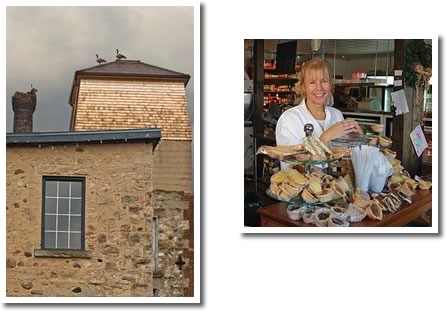
The Alton Mill, Kim Hall at her shop The Carver’s Block in Erin. Photos by Craig Bell and Kate Subak.
Passing down Erin’s Main Street, I pick up a loaf of multigrain at Holtom’s, chat with the girl at the counter, then head back home. The heavy blanket of fog has dissolved into a delicate mist by the time I roll back into my driveway. As often happens, I catch my neighbour Mark returning from his morning walk. We shoot the breeze about our trip, politics, in-laws. As always, the exchange ends in some irreverent punch line.
At last, I settle into my office, coffee in hand, I pause a moment to soak in the emerging panorama of the escarpment rising up beyond the Credit River outside my back window. And through my lingering haze of jetlag, one clear final lesson comes to mind. At least from my vantage point, all this is enough.

